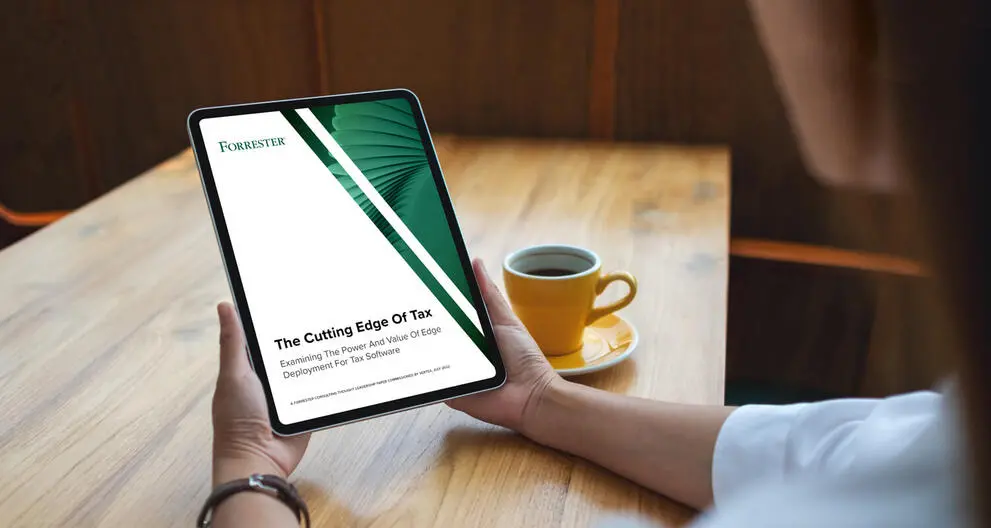Performance, Flexibility and Control: Achieving High Marks with Tax ‘Edge-ucation’

Tax departments have always had a daunting task to maintain compliance with constantly changing regulations. However, over the last several years many organizations around those tax departments have made major technological upgrades including new features, technology, and ways to interact with customers. These myriad new considerations invite friction into the tax compliance process. How does a tax department ensure their needs are being met by IT when so many new ways to interact with the customer and check out are being implemented? IT departments know that building complex systems means deploying software purposefully to solve problems. One of the ways they do this is by using edge computing technology. The International Data Corporation (IDC) projects edge computing systems to surge in the next few years.
IDC describes edge computing as the technology-related actions performed outside of the centralized data center, where edge functions as the intermediary between connected endpoints and the core IT environment. “The value of edge,” according to the IDC, “is the movement of computing resources to the physical location where data is created, dramatically reducing time to value and the instant enablement of business processes, decisions and intelligence outside of the core IT environment.”
Tax-focused edge computing solutions help organizations calculate tax at a local point (such as a check-out terminal at a physical retail store or a remote work center in a global organization) while simultaneously managing those transactions centrally. This capability helps maximize the performance, reliability, accuracy and security of a company’s tax system. Vertex Principal Architect of Innovation Eric Christian provides a rundown of edge computing and how the technology applies to the tax department and tax calculations, in this Tax Matters podcast.
Realizing the benefits of edge computing for tax requires the tax and IT departments to be on the same page regarding technology investments. But survey research from Forrester Consulting suggests that IT and tax are not as aligned as they should be concerning edge computing solutions. Forrester reports that nearly half of IT decision-makers (46%) indicated that it would be difficult to convince their business and tax colleagues to enhance tax systems with edge technology due to mostly a lack of knowledge or perceived value.
While most IT groups have derived substantial value from their own use of edge computing, many tax teams need a better understanding of these solutions and the benefits they deliver. Tax professionals can advance their “edge-ucation” by considering the following learnings:
- Corporate edge computing investments are rapidly expanding: “Edge computing has gone mainstream,” notes IDC Research Vice President, Cloud and Edge Infrastructure Services Dave McCarthy. The research and advisory firm projects that global spending on edge computing will increase 13.1% this year, reaching $208 billion. By 2026, total edge spending is forecast to hit $317 billion, according to the IDC.
- Edge computing solutions give tax groups more accuracy and reliability: As Vertex Technology Product Marketing Manager Steven Johnston notes, edge solutions for tax increase the volume of transactions that can be processed at one time and decreases the chance of inviting friction into the tax process. Friction, such as network delays and outages, can lead to failing over to a less accurate backup, missing tax on some transactions and even lost transactions. “Edge computing can allow a customer to adopt a tax engine directly at the point of sale which will increase accuracy and significantly lower maintenance efforts without inviting friction into the process,” adds Steve.
- Edge solutions for tax also strengthen data security and privacy: An edge tax solution keeps transactions within the company’s firewall, which helps fortify data security. Calling for tax across the internet is a potential vulnerability to your network. Keeping the tax calculation local removes this issue and allows for a more secure network overall.
- Edge computing delivers more flexibility: Edge solutions allow organizations to deploy their tax engines alongside every system that needs it. They are deployed in minutes and maintained with automation, so as the organization grows and adds more systems to support more business processes, an edge computing system for tax will evolve and grow with the overall system, seamlessly adapting to new and changing systems. If a single cloud environment experiences a surge in transactions, latency or an outage, the edge application continues to operate in another cloud environment — providing the confidence of a highly stable system that can handle as much volume as you can throw at it.
That’s definitely the SparkNotes version of an edge primer. It’s important for tax professionals to continue educating themselves on edge solutions and other emerging technologies. Doing so can help pave the way for better tax and IT alignment and will get their organization further down the road to optimizing their investments in new automation.
Disclaimer
Please remember that the Vertex blog provides information for educational purposes, not specific tax or legal advice. Always consult a qualified tax or legal advisor before taking any action based on this information. The views and opinions expressed in the Vertex blog are those of the authors and do not necessarily reflect the official policy, position, or opinion of Vertex Inc.
Blog Author
Explore the Cutting Edge of Tax
Learn how implementing a containerized edge solution for tax can help maximize value.
READ REPORT
